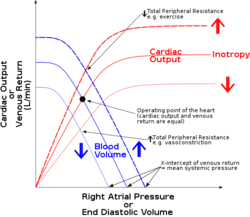Copy link
CHF Frank Starl curve: Milrinone eff
Last updated: 03/04/2015
The intrinsic property of myocardium to increase the force of contraction in relationship to the stretch of cardiac muscle is the Frank-Starling relationship. This relationship is commonly used to describe the influence of ventricular end-diastolic volume (LVEDV or preload) on stroke volume (SV) and is illustrated to the left. Increasing preload will increase the performance of myocardium and produce a larger stroke volume until excessive stretch occurs at which point the SV may plateau or decrease (although whether or not SV can actually decrease in humans is controversial).
The inotropic (contractile) state of the heart specifies the relationship curve between LVEDV and SV, such that a lower contractile state (i.e. heart failure) will produce a lower stroke volume at the same LVEDV. Increases in contractility, such as exercise and inotropic agents (epinephrine, norepinephrine, milrinone), will increase SV at a given LVEDV, producing a curve that is shifted up and to the left of the previous contractile state.
As a phosphodiesterase III inhibitor, milrinone increases the intracellular myocardial level of cAMP by preventing its degradation. This increase in cAMP results in a longer, more forceful myocardial contraction thereby improving the inotropic state of the heart. Milrinone also increases myocardial relaxation (lusiotropy), causes systemic and pulmonary vasodilation with resulting decreases in SVR, PVR, and PCWP. In a study of post-bypass cardiac surgery patients, milrinone improved cardiac output through improved LV function (Kikura et al, Feneck et al.).

References
- M Kikura, J H Levy, L G Michelsen, J S Shanewise, J M Bailey, S M Sadel, F Szlam The effect of milrinone on hemodynamics and left ventricular function after emergence from cardiopulmonary bypass. Anesth. Analg.: 1997, 85(1);16-22 PubMed Link
Copyright Information

This work is licensed under a Creative Commons Attribution-NonCommercial-NoDerivatives 4.0 International License.